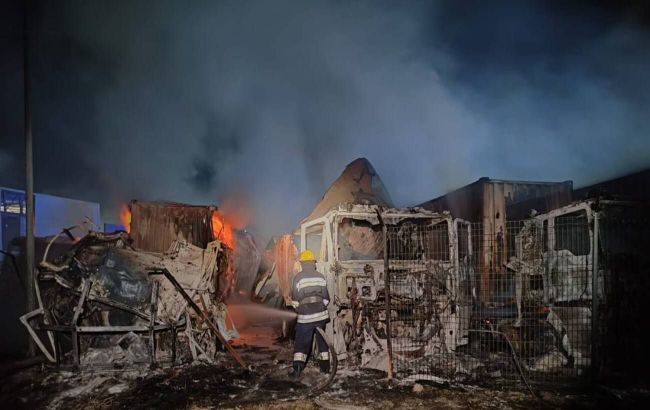Drone's attack on ports, checkpoints and missile strikes: Consequences of night shelling of Ukraine
 Russians fired dozens of Shaheds at southern Ukraine (Photo: t.me/odeskaODA)
Russians fired dozens of Shaheds at southern Ukraine (Photo: t.me/odeskaODA)
Russian forces once again launched a drone attack and used missiles during the night of September 26. As a result of the shelling on the border between Ukraine and Romania, a border crossing point was damaged, there were casualties, and the port infrastructure in the Odesa region was hit once more.
The RBC-Ukraine has compiled everything known about the consequences of this Russian attack.
During the preparation of this material, the following sources were used: the Head of the United Coordinating Press Center of Security and Defense Forces of the South of Ukraine, Natalia Humeniuk, the head of the Odesa Regional State Administration, Oleh Kiper, the Ministry of Internal Affairs (MIA), the State Emergency Service of Ukraine (SESU), the State Border Guard Service of Ukraine, the head of the Kherson Regional State Administration, and the Governor of Dnipropetrovsk Serhii Lysak, Yurii Ihnat, the spokesperson of the Air Forces Command of the Armed Forces of Ukraine,
Odesa region
Russian forces launched a drone attack on the Odesa region for two hours. Most of the drones were shot down. However, there were direct hits on the port infrastructure in the Izmail district, as reported by the Odesa Regional State Administration.
Photo: The enemy terrorized the Danube region of Odesa region again (t.me/odeskaODA)
The Shahed's attack also targeted border infrastructure, resulting in fires in the waiting zone at the international crossing point. Information on two injured drivers who received medical assistance is also available.
There was a significant risk to the bus passengers preparing to cross the border. The crossing point building, warehouse facilities, approximately 30 trucks, and 6 trucks caught fire. Firefighters extinguished the fires.
Later, Natalia Humeniuk, the Head of the United Coordinating Press Center of Security and Defense Forces of the South of Ukraine
, clarified that the incident occurred at the Orlivka-Isaccea crossing point between Ukraine and Romania in the Odesa region.
She also refuted information circulating on social media claiming that the drones had crossed into Romanian territory.
"We have received no statement from the neighboring state confirming such facts. We also did not record anything similar," Humeniuk noted.
State Border Guard Service of Ukraine confirms suspension of crossing point operation
The State Border Guard Service of Ukraine temporarily suspended the operation of the ferry crossing point Orlivka in the Odesa region. Currently, efforts are underway to stabilize operations following the nighttime enemy attack. Border guards are advising travelers to choose alternative routes to Romania.
Shahed attack on the Odesa region was filmed from the Romanian shore
According to the local channel Digi24, people on the Romanian side of the crossing witnessed the arrival of one of the Shahed drones.
Footage captured from the Isaccea customs facility shows massive flames from the explosions. The person recording the video urgently calls out to their colleagues on the barge to evacuate the port as quickly as possible.
The citizens of Isaccea reported hearing loud noises and seeing five to six drones during the night.
Mykolaiv region
While the occupant's attack was primarily focused on the Odesa region, the Armed Forces of the Russian Federation also significantly impacted the Mykolaiv region, however, due to debris falling from a downed UAV, a rural agricultural enterprise caught fire.

Photo: Aftermath of the Russian attack on Mykolaiv region (t.me/dsns_telegram)
According to the State Emergency Service of Ukraine, in the territory of the Bereznehuvate territorial community in the Bashtansky district, a fire broke out on the premises of an agricultural enterprise due to the debris falling from a shot-down UAV. Rescuers managed to extinguish the fire, covering an area of 700 square meters.
Preliminarily, no casualties or injuries were reported due to the shelling.
On the evening of September 25, the Russians launched a missile strike on Mykolaiv. The enemy targeted an infrastructure object on the city's outskirts, resulting in a fire in dry grass and shrubs.
Additionally, train traffic between Mykolaiv and Kherson has been temporarily suspended due to the shelling of infrastructure in the Mykolaiv region.
Passengers of train 218 to Kherson will be transported by shuttle buses in cooperation with the Mykolaiv and Kherson military administrations. A similar transfer is expected for passengers on the Kherson-Mykolaiv section, as announced by Ukrzaliznytsia (Ukrainian Railways).
Kherson region
Frontline areas of the Kherson Region also suffered enemy attacks. The Russian Armed Forces employed tactical aviation and directed guided air bombs at populated areas.
According to the Kherson Regional State Administration, Russian forces shelled Kherson and the villages of Kyselivka and Olhivka throughout the previous evening and this morning.
Currently, there is information about a minimum of 5 injured individuals.
Cherkasy region
The start of the day was also alarming for the Cherkasy region. Overnight, occupying forces launched drone attacks with Shahed drones.
Air Defense Forces managed to shoot down four enemy aerial targets. However, there were hits on an infrastructure object. Preliminary reports indicate no casualties. The cleanup of the aftermath is currently underway.
Kryvyi Rih
The morning began with an explosion in Kryvyi Rih, Dnipropetrovsk Region. The blows targeted one of the city's enterprises. According to local authorities, the Russians used ballistic weaponry (Iskander-M).
The head of the Kryvyi Rih Regional Military Administration, Evgeniy Sytnychenko, clarified that there were no casualties or damages.
"Today, the Russians struck the territory of the Kryvyi Rih district. Specifically, within the city limits, one of the enterprises was hit. Thank God, no one was harmed. There is no significant damage. The State Emergency Service teams have already arrived. Everything has been resolved," he stated during a televised broadcast.
Additionally, the Nikopol region was traditionally under attack at night. The enemy fired heavy artillery rounds, affecting the regional center and the Myrivska and Chervonohryhorivska communities.
Three private houses and two outbuildings were damaged. Forty solar panels were destroyed, and an unused building and power lines were also affected. Fortunately, there were no casualties.
Methods used by the Russians
According to the Ukrainian Air Force, the occupiers conducted the nighttime attack using Shahed drones. A total of 38 drones were launched from the southeast direction.
Air defense measures successfully destroyed 26 enemy UAVs.
According to Natalia Humeniuk, 10 Shahed drones were shot down over the Odesa region, 3 over the Kherson region, 6 over the Mykolaiv region, and 3 over the Kirovohrad region.
Furthermore, the spokesperson of the Air Forces Command of the Armed Forces of Ukraine, Yurii Ihnat, mentioned that, besides drones, Iskander ballistic missiles and Kh-59 missiles were detected.
The enemy also actively used reconnaissance drones for fire correction.
"Last night, 38 UAVs were launched simultaneously from both directions. This is the Chauda Cape - Crimea and Prymorsk-Akhtarsk - Russia. These drones flew in different directions, but each drone had a separate route programmed by operators before the assignment of this strike," Ihnat explained.
He also clarified that achieving a 100% success rate, as they did the day before, was impossible because the kamikaze drones are resistant to electronic warfare and are, therefore a challenging target for air defense systems.

